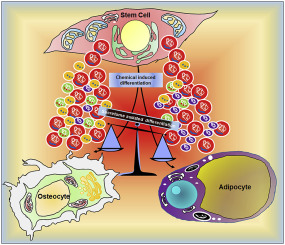Biochimie ( IF 3.9 ) Pub Date : 2018-10-24 , DOI: 10.1016/j.biochi.2018.10.014 Ajay Kumar , Vinod Kumar , Vidya Rattan , Vivekananda Jha , Shalmoli Bhattacharyya

|
Introduction
Dental stem cells (DMSC) have been studied extensively since their early discovery. However, the data regarding osteogenic potential of DMSC with other cell types is sparse and the secretome proteins underlying these differences have not been explored. In this study, we have compared the osteogenic and adipogenic potential of DMSC with Bone Marrow Stem cells (BMSC) and reported the contribution of secretome proteins in controlling their differentiation.
Methods
Osteogenic potential of these stem cells was compared by mineralization assay, alkaline phosphatase (ALP) assay, immunofluorescence of dentine sialo phosphoprotein (DSPP) & qPCR for osteogenic genes. Adipogenic potential was compared by Oil Red O staining and qPCR for PPAR-γ, leptin & adipsin. Proteomic analysis of secretome was performed by employing WATERS nano Lc-MS/MS system.
Results
We observed a higher osteogenic potential in DMSC, especially dental pulp stem cells (DPSC) as compared to BMSC population but adipogenic potential was found to be better in BMSC as compared to DMSC. Deeper investigations into secretome of these cells by Lc-MS/MS revealed the presence of proteins pertaining to osteogenic and adipogenic lineage. Presence of some important proteins regulating osteogenic (DSPP, BMP7, DDR2, USP9X) and adipogenic differentiation (NCOA2, PEG10, LPA) in secretome of BMSC and DMSC reflected the role of paracrine factors during differentiation.
Conclusion
Our study provides first evidence regarding regulation of osteogenic/adipogenic potential by secretome proteins in DMSC and BMSC. DMSC especially DPSC and its secretome show an inherent tendency for higher osteogenic differentiation and lower adipogenic differentiation, these may be potential candidates for effective future therapy in osteoporosis where disturbance of osteocyte/adipocyte homeostasis is reported.
中文翻译:

分泌组蛋白调节骨髓和牙齿干细胞中的成骨和成脂潜能
介绍
自从牙科干细胞(DMSC)的早期发现以来,已经对其进行了广泛的研究。但是,有关DMSC与其他细胞类型的成骨潜能的数据很少,并且尚未探究这些差异背后的分泌蛋白。在这项研究中,我们比较了DMSC与骨髓干细胞(BMSC)的成骨和成脂潜力,并报道了分泌蛋白在控制其分化中的作用。
方法
通过矿化分析,碱性磷酸酶(ALP)分析,牙本质唾液磷蛋白(DSPP)的免疫荧光和qPCR对成骨基因进行比较,比较了这些干细胞的成骨潜能。通过油红O染色和qPCR比较了PPAR-γ,瘦素和脂肪酶的成脂潜能。分泌组的蛋白质组学分析是通过使用WATERS纳米Lc-MS / MS系统进行的。
结果
我们观察到DMSC中,尤其是牙髓干细胞(DPSC)与BMSC群体相比具有更高的成骨潜能,但与DMSC相比,BMSC中的成脂潜能更好。通过Lc-MS / MS对这些细胞的分泌组进行更深入的研究,发现存在与成骨和成脂谱系有关的蛋白质。BMSC和DMSC分泌物中调节骨形成的一些重要蛋白质(DSPP,BMP7,DDR2,USP9X)和成脂分化(NCOA2,PEG10,LPA)的存在反映了旁分泌因子在分化过程中的作用。
结论
我们的研究提供了有关DMSC和BMSC中的分泌蛋白调节骨形成/成脂潜能的第一个证据。DMSC尤其是DPSC及其分泌物组显示出更高的成骨性分化和更低的成脂性分化的固有趋势,这些可能是将来据报道骨细胞/脂肪细胞稳态紊乱的骨质疏松症的有效未来治疗的潜在候选者。



























 京公网安备 11010802027423号
京公网安备 11010802027423号